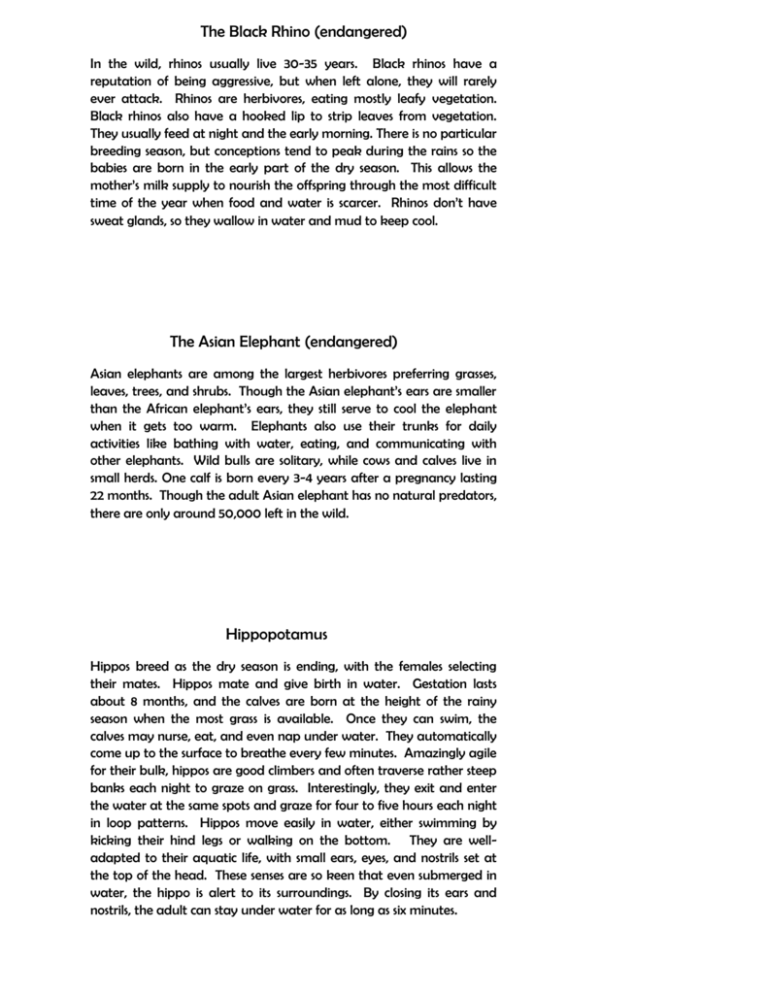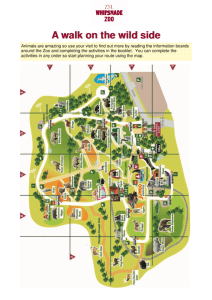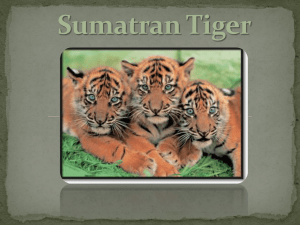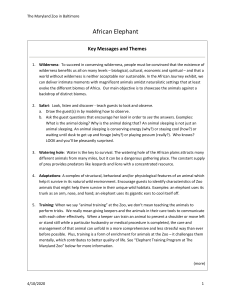Tropical Dry Forest
advertisement

The Black Rhino (endangered) In the wild, rhinos usually live 30-35 years. Black rhinos have a reputation of being aggressive, but when left alone, they will rarely ever attack. Rhinos are herbivores, eating mostly leafy vegetation. Black rhinos also have a hooked lip to strip leaves from vegetation. They usually feed at night and the early morning. There is no particular breeding season, but conceptions tend to peak during the rains so the babies are born in the early part of the dry season. This allows the mother’s milk supply to nourish the offspring through the most difficult time of the year when food and water is scarcer. Rhinos don’t have sweat glands, so they wallow in water and mud to keep cool. The Asian Elephant (endangered) Asian elephants are among the largest herbivores preferring grasses, leaves, trees, and shrubs. Though the Asian elephant’s ears are smaller than the African elephant’s ears, they still serve to cool the elephant when it gets too warm. Elephants also use their trunks for daily activities like bathing with water, eating, and communicating with other elephants. Wild bulls are solitary, while cows and calves live in small herds. One calf is born every 3-4 years after a pregnancy lasting 22 months. Though the adult Asian elephant has no natural predators, there are only around 50,000 left in the wild. Hippopotamus Hippos breed as the dry season is ending, with the females selecting their mates. Hippos mate and give birth in water. Gestation lasts about 8 months, and the calves are born at the height of the rainy season when the most grass is available. Once they can swim, the calves may nurse, eat, and even nap under water. They automatically come up to the surface to breathe every few minutes. Amazingly agile for their bulk, hippos are good climbers and often traverse rather steep banks each night to graze on grass. Interestingly, they exit and enter the water at the same spots and graze for four to five hours each night in loop patterns. Hippos move easily in water, either swimming by kicking their hind legs or walking on the bottom. They are welladapted to their aquatic life, with small ears, eyes, and nostrils set at the top of the head. These senses are so keen that even submerged in water, the hippo is alert to its surroundings. By closing its ears and nostrils, the adult can stay under water for as long as six minutes. Tiger (endangered/extinct) The tiger is a member of the Felidae family. Tigers are solitary animals often requiring large contiguous areas of habitat that support their prey demands. Of the nine subspecies of modern tigers, three are extinct and the remaining six are classified as endangered. The mating season is mostly from November to April. After a gestation of 100 to 112 days, 2 to 3 cubs are born. The cubs are blind and helpless and weigh about 1 kg each. The tiger is a carnivore and prefers deer and wild boar. The tiger’s body is built for capturing and killing large prey through stealth and sudden attack. Its powerful limbs and a flexible backbone enable tigers to quickly chase and catch prey over short distances. They can cover up to 33 ft. in a single leap! The Tropical Dry Forest Tropical dry forests, in contrast to rainforest, have to survive a long dry season each year, so trees and plants must be able to survive periods of low precipitation and moisture. Tropical forests don’t have winter. They only have 2 seasons, dry and rainy. The average rainfall is sufficient enough to promote growth of trees, but these tree and plant species must be able to withstand periods of low precipitation and moisture. Many of the tree species in dry forests are also deciduous. In order to survive, trees have thicker, more ridged bark; deeper roots, much more variable leaves; and more types with thorns. During the driest months these species will drop their leaves in the fall and winter. This dry season leaf-drop reduces the water needs of the plant, as there is no evapotranspiration through the leaves. Sunlight can then reach the ground, so the season that’s bad for the trees is good for the forest floor. The length of daylight is 12 hours and the average temperature is about 68-77˚ F and varies little throughout the year. Soil is nutrient-poor and acidic. Decomposition is rapid and soils are subject to heavy leaching. Most animals have to do adaptations in order to survive the dry weather since dry seasons are extremely long. The dominant wild life is tigers, monkeys; herbivores such as elephants, Indian rhinoceros, hog deer; birds such as great pied hombill, pied harrier, and spotbilled pelican; insects such as termites; reptiles such as snakes and monitor lizards. Abiotic: Generally warm year-round; alternating wet and dry seasons; rich soils subject to erosion, rocks, soil, sunlight, and dense foliage. Biotic: Wild plant and animal life.











